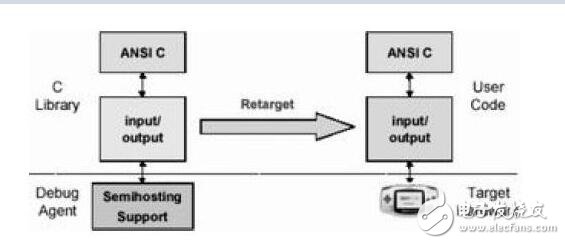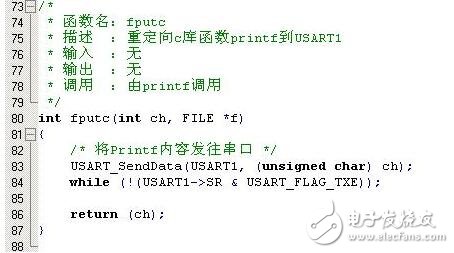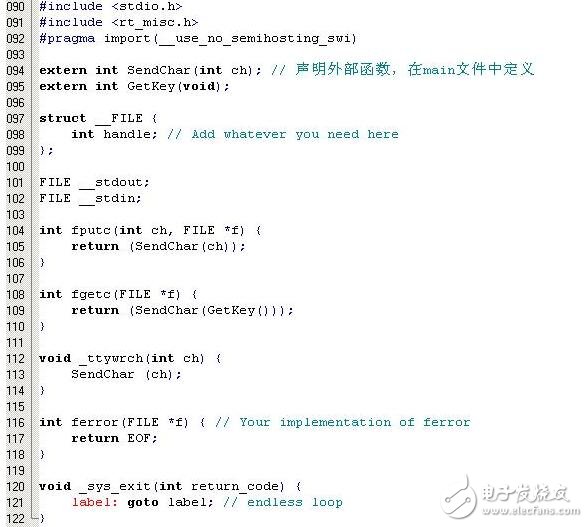

关于printf重定向到串口的问题分析
编程语言及工具
描述
关于printf重定向到串口的问题
简单地说:想在mdk 中用printf,需要同时重定义fputc函数和避免使用semihosting(半主机模式),
标准库函数的默认输出设备是显示器,要实现在串口或LCD输出,必须重定义标准库函数里调用的与输出设备相关的函数。
例如:printf输出到串口,需要将fputc里面的输出指向串口(重定向),方法如下:

#ifdef __GNUC__
/* With GCC/RAISONANCE, small printf (option LD Linker-》Libraries-》Small printf
set to ‘Yes’) calls __io_putchar() */
#define PUTCHAR_PROTOTYPE int __io_putchar(int ch)
#else
#define PUTCHAR_PROTOTYPE int fputc(int ch, FILE *f)
#endif /* __GNUC__ */
PUTCHAR_PROTOTYPE
{
/* Place your implementation of fputc here */
/* e.g. write a character to the USART */
USART_SendData(USART1, (uint8_t) ch);
/* Loop until the end of transmission */
while (USART_GetFlagStatus(USART1, USART_FLAG_TC) == RESET);
return ch;
}
因printf()之类的函数,使用了半主机模式。使用标准库会导致程序无法运行,以下是解决方法:
方法1.使用微库,因为使用微库的话,不会使用半主机模式。
方法2.仍然使用标准库,在主程序添加下面代码:
#pragma import(__use_no_semihosting)
_sys_exit(int x)
{
x = x;
}
struct __FILE
{
int handle;
/* Whatever you require here. If the only file you are using is */
/* standard output using printf() for debugging, no file handling */
/* is required. */
};
/* FILE is typedef’ d in stdio.h. */
FILE __stdout;
如果使用的是MDK,请在工程属性的“Target“-》”Code Generation“中勾选”Use MicroLIB;今天参考了一下论坛,使用微库可以很好的解决这个问题。
2.另一种方法:(其实大同小异)
需要添加以下代码
(论坛里应该有完整介绍这个的帖子,但是我没搜到,也许是沉了。)
#pragma import(__use_no_semihosting)
/******************************************************************************
*标准库需要的支持函数
******************************************************************************/
struct __FILE
{
int handle;
/* Whatever you require here. If the only file you are using is */
/* standard output using printf() for debugging, no file handling */
/* is required. */
};
/* FILE is typedef’ d in stdio.h. */
FILE __stdout;
/// 《summary》
/// 定义_sys_exit()以避免使用半主机模式
/// 《/summary》
/// 《param name=“x”》《/param》
/// 《returns》《/returns》
_sys_exit(int x)
{
x = x;
}
int fputc(int ch, FILE *f)
{
//USART_SendData(USART1, (u8) ch);
USART1-》DR = (u8) ch;
/* Loop until the end of transmission */
while(USART_GetFlagStatus(USART1, USART_FLAG_TXE) == RESET)
{
}
return ch;
}
semihosting的作用,介绍如下
Semihosting is a mechanism for ARM targets to communicate input/output requests
from application code to a host computer running a debugger. This mechanism could be
used, for example, to allow functions in the C library, such as printf() and scanf(), to use the screen and keyboard of the host rather than having a screen and keyboard on the target system.
This is useful because development hardware often does not have all the input and
output facilities of the final system. Semihosting allows the host computer to provide these facilities.
Semihosting is implemented by a set of defined software interrupt (SWI) operations.
The application invokes the appropriate SWI and the debug agent then handles the SWI
exception. The debug agent provides the required communication with the host.
In many cases, the semihosting SWI will be invoked by code within library functions. The application can also invoke the semihosting SWI directly. Refer to the C library descriptions in the ADS Compilers and Libraries Guide for more information on support for semihosting in the ARM C library.
按我的理解,这个模式是用来调试的,通过仿真器,使用主机的输入输出代替单片机自己的,也就是说即便单片机没有输出口也能printf到电脑上。反过来,由于这个模式更改了printf()等的实现方式,输入输出就不走单片机的外设了,所以只重定义fputc不起作用。
用代码关闭此模式后,需要同时更新一下__stdout 和__stdin 的定义,所以有后面的语句。
以上仅为个人理解,如有错误请指正。
另外,勾选microlib之后,也许编译的时候就不把开启semihosting的文件包进去了,所以没事。
C库函数重定向:
用户能定义自己的C语言库函数,连接器在连接时自动使用这些新的功能函数。这个过程叫做重定向C语言库函数,如下图所示。
举例来说,用户有一个I/O设备(如UART)。本来库函数fputc()是把字符输出到调试器控制窗口中去的,但用户把输出设备改成了UART端口,这样一来,所有基于fputc()函数的printf()系列函数输出都被重定向到UART端口上去了。
下面是实现fputc()重定向的一个例子:
externvoidsendchar(char*ch);
intfputc(intch,FILE*f)
{/*e.g.writeacharactertoanUART*/
chartempch=ch;
sendchar(&tempch);
returnch;
}
这个例子简单地将输入字符重新定向到另一个函数sendchar(),sendchar()假定是个另外定义的串口输出函数。在这里,fputc()就似乎目标硬件和标准C库函数之间的一个抽象层。
STM32中关于串口通信的printf函数重定向问题
在STM32串口通信程序中使用printf()函数发送数据非常方便,但是需要先进行简单的配置,下面介绍两种配置方法。
方法一、对工程属性进行配置
第1步:在main.c中包含“stdio.h” (标准输入输出头文件);
第2步:在main.c文件中重定义fput()这个C标准库函数(因为printf()在C标准库函数中实质上是一个宏,要调用到fputc()这个函数);

第3步:在工程属性的”Target“ -》 ”Code Generation“ 选项中勾选”Use MicroLIB“;

方法二:在工程中添加“regtarge.c”文件
第1步:在main.c文件中包含”stdio.h”文件;
第2步:在工程中创建一个文件保存为“regtarge.c”,然后将其添加到工程中;

第3步:在main文件中添加定义以下两个函数

至此完成配置,可以在main.c文件中随意调用printf() 。
- 相关推荐
- 热点推荐
- Printf
-
如何实现Printf()接口重定向到UART2023-10-01 2142
-
printf输出重定向的方法2023-05-14 6609
-
重定向printf() 函数2022-01-11 1298
-
Keil下使用STlink重定向printf的配置2021-12-27 1846
-
STM32串口的介绍与使用(原理、结构体、发送字符串、printf函数重定向)2021-12-24 1442
-
STM32单片机IAR环境下重定向printf函数2021-12-03 1631
-
如何将printf函数重定向到串口?2021-12-01 1296
-
单片机printf( )重定向到串口2021-11-29 930
-
嵌入式Linux中printf重定向到串口2021-11-01 1099
-
重定向printf到串口打印输出2021-08-24 1015
-
Keil C51重定向printf到串口的程序免费下载2019-07-19 1091
-
实现重定向printf()和scanf() 函数案例分析2018-06-23 9938
全部0条评论

快来发表一下你的评论吧 !

